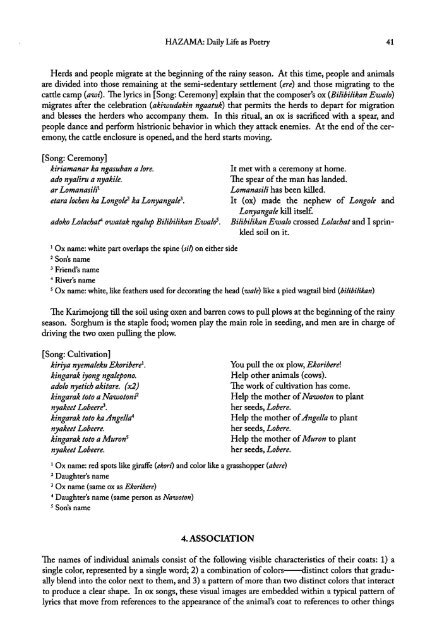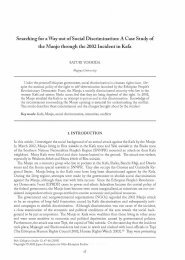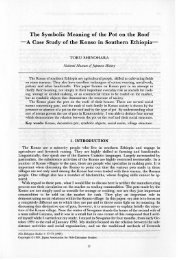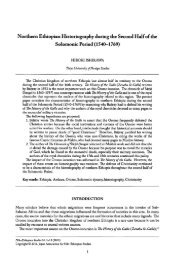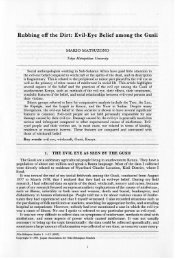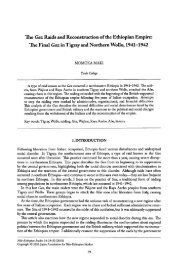Daily Life as Poetry: The Meaning of the Pastoral Songs of the ...
Daily Life as Poetry: The Meaning of the Pastoral Songs of the ...
Daily Life as Poetry: The Meaning of the Pastoral Songs of the ...
You also want an ePaper? Increase the reach of your titles
YUMPU automatically turns print PDFs into web optimized ePapers that Google loves.
HAZAMA: <strong>Daily</strong> <strong>Life</strong> <strong>as</strong> <strong>Poetry</strong> 41<br />
Herds and people migrate at <strong>the</strong> beginning <strong>of</strong> <strong>the</strong> rainy se<strong>as</strong>on. At this time, people and animals<br />
are divided into those remaining at <strong>the</strong> semi-sedentary settlement (ere) and those migrating to <strong>the</strong><br />
cattle camp (awi). <strong>The</strong> lyrics in [Song: Ceremony] explain that <strong>the</strong> composer's ox (Bilibilikan Ewalo)<br />
migrates after <strong>the</strong> celebration (akiwudakin ngaatuk) that permits <strong>the</strong> herds to depart for migration<br />
and blesses <strong>the</strong> herders who accompany <strong>the</strong>m. In this ritual, an ox is sacrificed with a spear, and<br />
people dance and perform histrionic behavior in which <strong>the</strong>y attack enemies. At <strong>the</strong> end <strong>of</strong> <strong>the</strong> ceremony,<br />
<strong>the</strong> cattle enclosure is opened, and <strong>the</strong> herd starts moving.<br />
[Song: Ceremony]<br />
kiriamanar ka ng<strong>as</strong>uban a lore.<br />
ado nyaliru a nyakile.<br />
ar Loman<strong>as</strong>ilt 1<br />
etara lochen ka Longoli? ka Lonyangalt?.<br />
adoko Lolachat owatak ngalup Bilibilikan Ewalu'.<br />
It met with a ceremony at home.<br />
<strong>The</strong> spear <strong>of</strong> <strong>the</strong> man h<strong>as</strong> landed.<br />
Loman<strong>as</strong>ili h<strong>as</strong> been killed.<br />
It (ox) made <strong>the</strong> nephew <strong>of</strong> Longole and<br />
Lonyangale kill itsel£<br />
Bilibilikan Ewalo crossed Lolachat and I sprinkled<br />
soil on it.<br />
1<br />
Ox name: white part overlaps <strong>the</strong> spine (si/) on ei<strong>the</strong>r side<br />
2<br />
Son's name<br />
3<br />
Friend's name<br />
4<br />
River's name<br />
5<br />
Ox name: white, like fea<strong>the</strong>rs used for decorating <strong>the</strong> head (wale) like a pied wagtail bird (bilibilikan)<br />
<strong>The</strong> Karimojong till <strong>the</strong> soil using oxen and barren cows to pull plows at <strong>the</strong> beginning <strong>of</strong> <strong>the</strong> rainy<br />
se<strong>as</strong>on. Sorghum is <strong>the</strong> staple food; women play <strong>the</strong> main role in seeding, and men are in charge <strong>of</strong><br />
driving <strong>the</strong> two oxen pulling <strong>the</strong> plow.<br />
[Song: Cultivation]<br />
kiriya nyemaleku Ekoribere 1 •<br />
kingarak iyong ngalepono.<br />
adolo nyetich akitare. (x2)<br />
kingarak toto a Nawotoni 2<br />
nyakeet Lobeert?.<br />
kingarak toto ka Angelltt<br />
nyakeet Lobeere.<br />
kingarak toto a Muron 5<br />
nyakeet Lobeere.<br />
You pull <strong>the</strong> ox plow, Ekoribere!<br />
Help o<strong>the</strong>r animals (cows).<br />
<strong>The</strong> work <strong>of</strong> cultivation h<strong>as</strong> come.<br />
Help <strong>the</strong> mo<strong>the</strong>r <strong>of</strong> Nawoton to plant<br />
her seeds, Lobere.<br />
Help <strong>the</strong> mo<strong>the</strong>r <strong>of</strong> Angel/a to plant<br />
her seeds, Lobere.<br />
Help <strong>the</strong> mo<strong>the</strong>r <strong>of</strong> Muron to plant<br />
her seeds, Lobere.<br />
1<br />
Ox name: red spots like giraffe (ekori) and color like a gr<strong>as</strong>shopper (abere)<br />
2<br />
Daughter's name<br />
3<br />
Ox name (same ox <strong>as</strong> Ekoribere)<br />
4<br />
Daughter's name (same person <strong>as</strong> Nawoton)<br />
5<br />
Son's name<br />
4.ASSOCIATION<br />
<strong>The</strong> names <strong>of</strong> individual animals consist <strong>of</strong> <strong>the</strong> following visible characteristics <strong>of</strong> <strong>the</strong>ir coats: 1) a<br />
single color, represented by a single word; 2) a combination <strong>of</strong> colors-distinct colors that gradually<br />
blend into <strong>the</strong> color next to <strong>the</strong>m, and 3) a pattern <strong>of</strong> more than two distinct colors that interact<br />
to produce a clear shape. In ox songs, <strong>the</strong>se visual images are embedded within a typical pattern <strong>of</strong><br />
lyrics that move from references to <strong>the</strong> appearance <strong>of</strong> <strong>the</strong> animal's coat to references to o<strong>the</strong>r things


